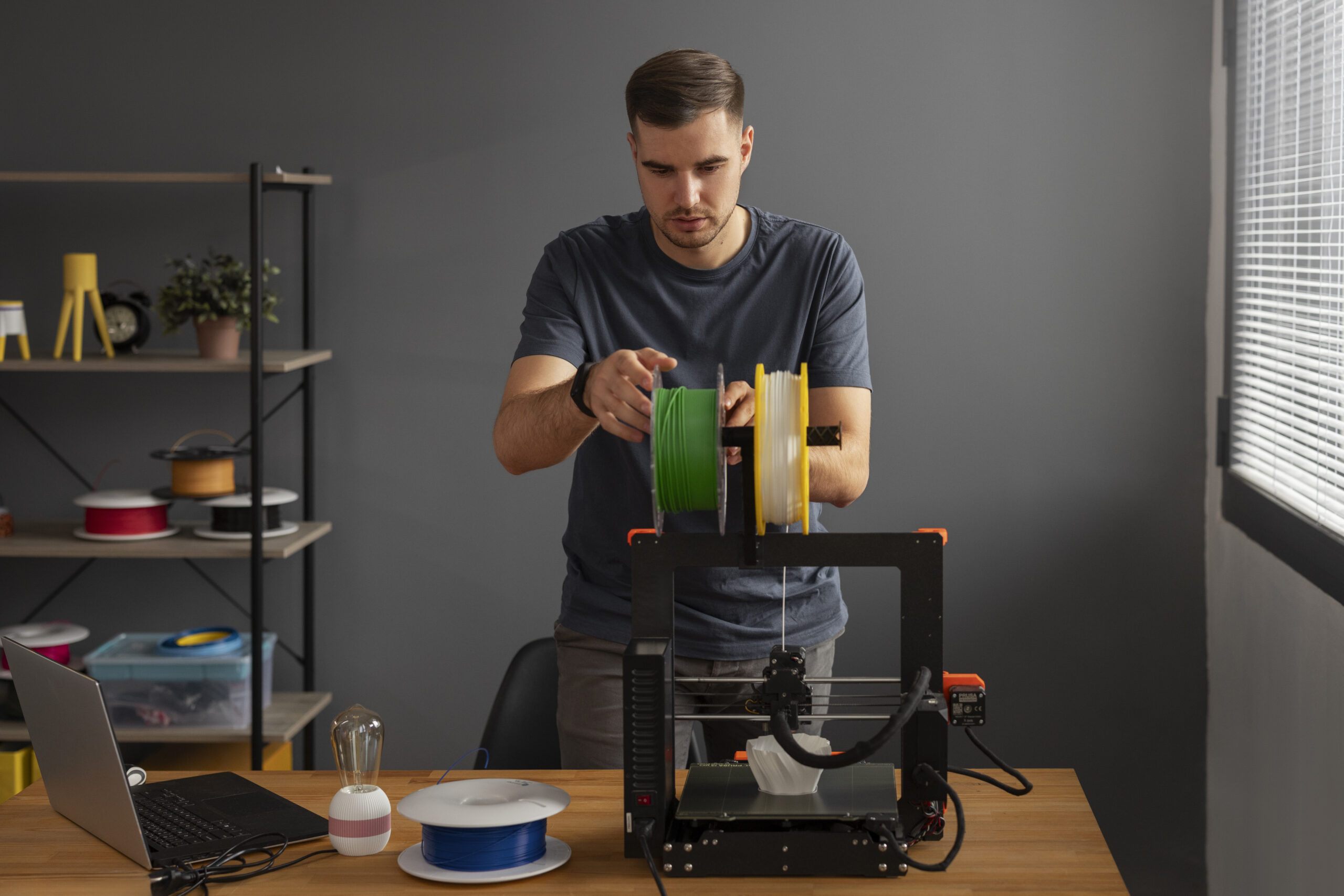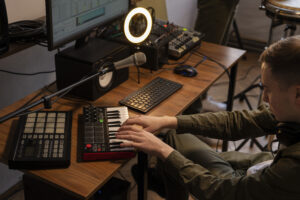3D printing has become increasingly popular in recent years, and it’s not hard to see why. From creating custom phone cases to making replacement parts for household items, the possibilities are endless. However, for beginners, choosing the right 3D printer can be overwhelming.
When it comes to selecting the best 3D printer for beginners, there are several factors to consider. These include ease of use, build quality, print quality, and price. Fortunately, there are many great options available that meet these criteria. In this article, we will be discussing the top 10 3D printers for beginners in 2024. Whether you’re new to 3D printing or looking to upgrade your current machine, this list will provide you with the information you need to make an informed decision.
Now we will talk about the best 3D printers for beginners from our point of view after studying the market
1. Creality Ender 3 V3 SE
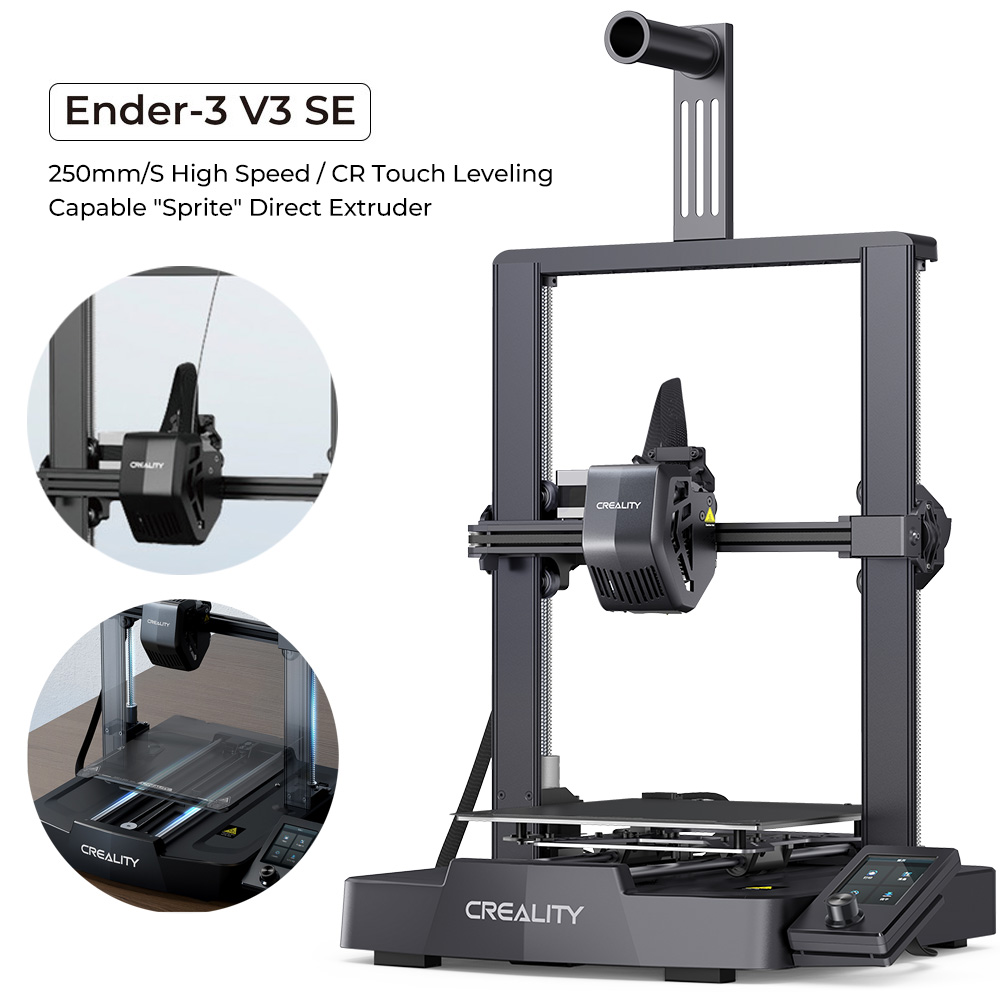
Quick Summary :
Embarking on the journey of 3D printing can be an exhilarating adventure, and the Creality Ender 3 V3 SE stands out as an ideal companion for beginners. Packed with features that streamline the learning process and enhance user experience, this 3D printer offers a seamless entry into the world of additive manufacturing.
1. Ease of Assembly:
One of the standout features for beginners is the Ender 3 V3 SE’s user-friendly assembly process. With a pre-assembled base and clear instructions, even those new to 3D printing can set up their machine with confidence. This eliminates the intimidation factor often associated with complex assembly, allowing users to dive into their first print swiftly.
2. Budget-Friendly Excellence:
For novice 3D printing enthusiasts, cost can be a significant concern. The Ender 3 V3 SE strikes an optimal balance between affordability and performance. Its budget-friendly price tag doesn’t compromise on print quality or durability, making it an attractive option for those entering the 3D printing realm without breaking the bank.
3. Print Quality and Precision:
Despite its economical price, the Ender 3 V3 SE delivers impressive print quality. Equipped with a sturdy frame and a reliable printing bed, it ensures stability during the printing process, resulting in precise and detailed prints. The printer’s compatibility with various filament types further expands creative possibilities for beginners eager to experiment with different materials.
4. Open-Source Community Support:
The Ender 3 V3 SE benefits from Creality’s commitment to an open-source approach. This means a vast and active community of users who willingly share tips, troubleshooting advice, and even enhancements to the printer. For beginners, having access to a supportive community can be invaluable, providing a safety net for any challenges encountered along the learning curve.
5. Upgradability and Modifiability:
As beginners progress in their 3D printing journey, the Ender 3 V3 SE grows with them. The printer’s modular design allows for easy upgrades and modifications. Users can enhance performance, add new features, or experiment with different components as they gain confidence and expertise, transforming their entry-level 3D printer into a customized, advanced tool.
Conclusion:
The Creality Ender 3 V3 SE serves as a beacon for beginners in the 3D printing realm, offering an accessible, affordable, and high-performance platform. From its straightforward assembly to the impressive print quality and the support of a vibrant community, this 3D printer stands as a testament to Creality’s commitment to providing an exceptional entry point for newcomers to the exciting world of additive manufacturing.
2. Bambu Lab A1 Mini
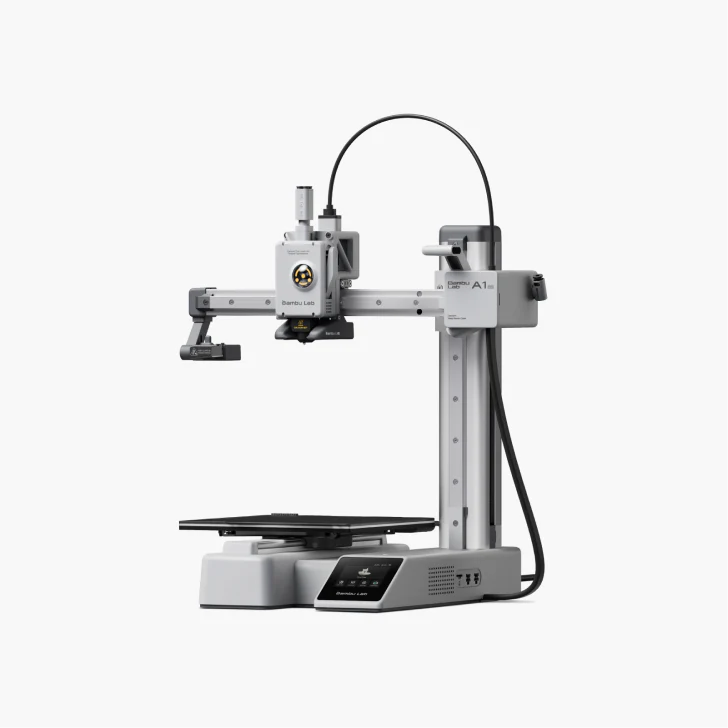
Quick Summary:
The Bambu Lab A1 Mini stands as a beacon of innovation, offering a myriad of benefits tailored specifically for beginners entering the tech realm. This compact marvel is not just a device; it’s a comprehensive experience that combines user-friendly features with cutting-edge technology. Let’s delve into the world of Bambu Lab A1 Mini and explore why it’s the perfect companion for tech novices.
1. Simplicity at its Core:
One of the standout advantages of the Bambu Lab A1 Mini is its user-friendly interface. Designed with beginners in mind, the device ensures a seamless and intuitive experience from the moment it’s unboxed. The simplified setup process and easy navigation make it an ideal choice for those taking their first steps into the world of technology.
2. Compact Design, Powerful Performance:
Despite its petite size, the Bambu Lab A1 Mini packs a punch in terms of performance. This miniature powerhouse is equipped with advanced features that cater to the needs of beginners without overwhelming them. Its nimble design allows for easy portability, making it convenient for users on the go.
3. Versatility in Connectivity:
The Bambu Lab A1 Mini is not just a device; it’s a gateway to connectivity. With a range of ports and wireless capabilities, beginners can effortlessly connect to other devices, expanding their tech horizons. Whether it’s syncing with smartphones or integrating with other gadgets, the A1 Mini provides a versatile platform for exploration.
4. Educational and Entertainment Hub:
Beyond its technical prowess, the Bambu Lab A1 Mini serves as an educational and entertainment hub for beginners. Pre-loaded with user-friendly applications and educational content, it facilitates a fun and informative learning experience. From educational apps to interactive games, users can seamlessly transition between work and play.
5. Budget-Friendly Accessibility:
Affordability is a key factor for beginners, and the Bambu Lab A1 Mini shines in this regard. It offers a budget-friendly entry point into the tech world without compromising on quality. The cost-effective nature of the device makes it an attractive option for those seeking value without breaking the bank.
Conclusion:
In essence, the Bambu Lab A1 Mini emerges as a beacon of accessibility, ushering beginners into the world of technology with open arms. Its user-friendly design, compact yet powerful features, versatile connectivity options, and budget-friendly accessibility make it an exemplary choice for those embarking on their tech journey. With the Bambu Lab A1 Mini, beginners not only acquire a device but a passport to a world of endless possibilities.
3. Anker Make M5 3D Printer
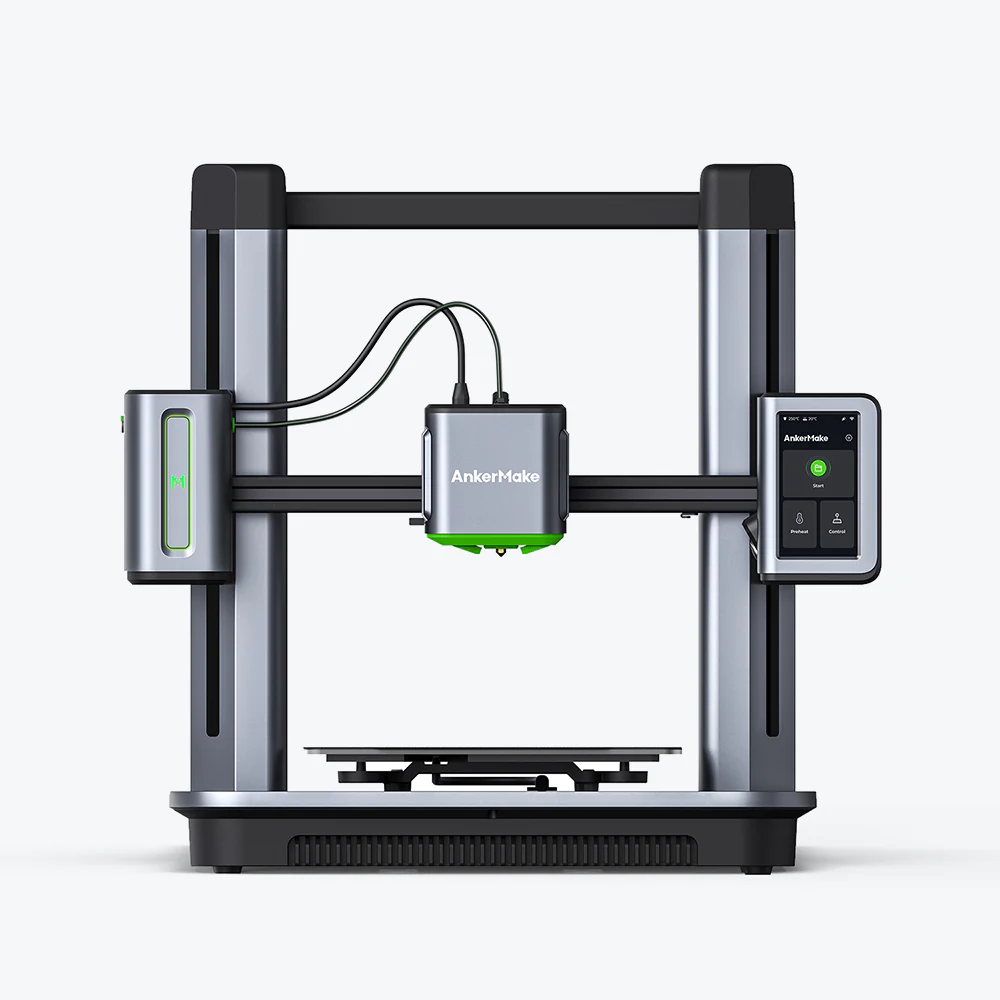
Quick Summary :
In the ever-expanding realm of 3D printing, the AnkerMake M5 emerges as a beacon for beginners, offering a seamless entry into the world of creative manufacturing. Packed with features tailored for novice users, this 3D printer promises a user-friendly experience without compromising on the quality of prints. Let’s explore the myriad benefits that make the AnkerMake M5 an ideal choice for those just stepping into the captivating universe of 3D printing.
1. User-Friendly Design:
The AnkerMake M5 boasts an intuitive design, engineered with beginners in mind. Its straightforward assembly process, accompanied by detailed instructions, ensures that even those with minimal technical expertise can set up the printer with ease. The user-friendly interface simplifies navigation, allowing newcomers to delve into the world of 3D printing without feeling overwhelmed.
2. Sturdy Construction and Durability:
Crafted with robust materials, the AnkerMake M5 stands as a testament to durability. The sturdy frame not only enhances the printer’s lifespan but also contributes to the stability required for precise and accurate prints. This reliability provides beginners with the confidence to experiment and learn without worrying about frequent maintenance or fragility.
3. Versatility in Material Compatibility:
One notable advantage of the AnkerMake M5 is its compatibility with a diverse range of printing materials. From standard PLA to more advanced filaments like ABS and PETG, users can experiment with various materials to bring their creative visions to life. This versatility allows beginners to explore different aspects of 3D printing and discover the ideal material for their specific projects.
4. Effortless Bed Leveling and Calibration:
Simplifying the often daunting task of bed leveling, the AnkerMake M5 incorporates user-friendly features such as automatic bed leveling. This ensures that the printing surface is precisely calibrated, reducing the likelihood of print failures and wasted materials. Such automation is particularly beneficial for beginners who may be unfamiliar with the intricacies of manual bed leveling.
5. Silent Printing Operation:
Recognizing the importance of a quiet working environment, the AnkerMake M5 is designed with a silent stepper motor driver. This feature minimizes operational noise, allowing users to enjoy a peaceful printing experience. For beginners exploring 3D printing in shared or residential spaces, the quiet operation of the AnkerMake M5 ensures a harmonious coexistence with the surrounding environment.
6. Accessible Technical Support and Community:
AnkerMake places a strong emphasis on customer support, providing beginners with access to a helpful community and responsive technical assistance. This support network proves invaluable for newcomers seeking guidance on troubleshooting, optimizing print settings, or exchanging creative ideas with fellow enthusiasts.
Conclusion:
In the realm of 3D printing, the AnkerMake M5 stands as a beacon for beginners, offering a seamless introduction to the exciting world of additive manufacturing. With its user-friendly design, sturdy construction, material versatility, and thoughtful features, the AnkerMake M5 empowers novices to unleash their creativity. This 3D printer serves as a stepping stone for beginners, guiding them toward a rewarding journey of limitless possibilities in the realm of three-dimensional creation.
4. Creality Ender 3
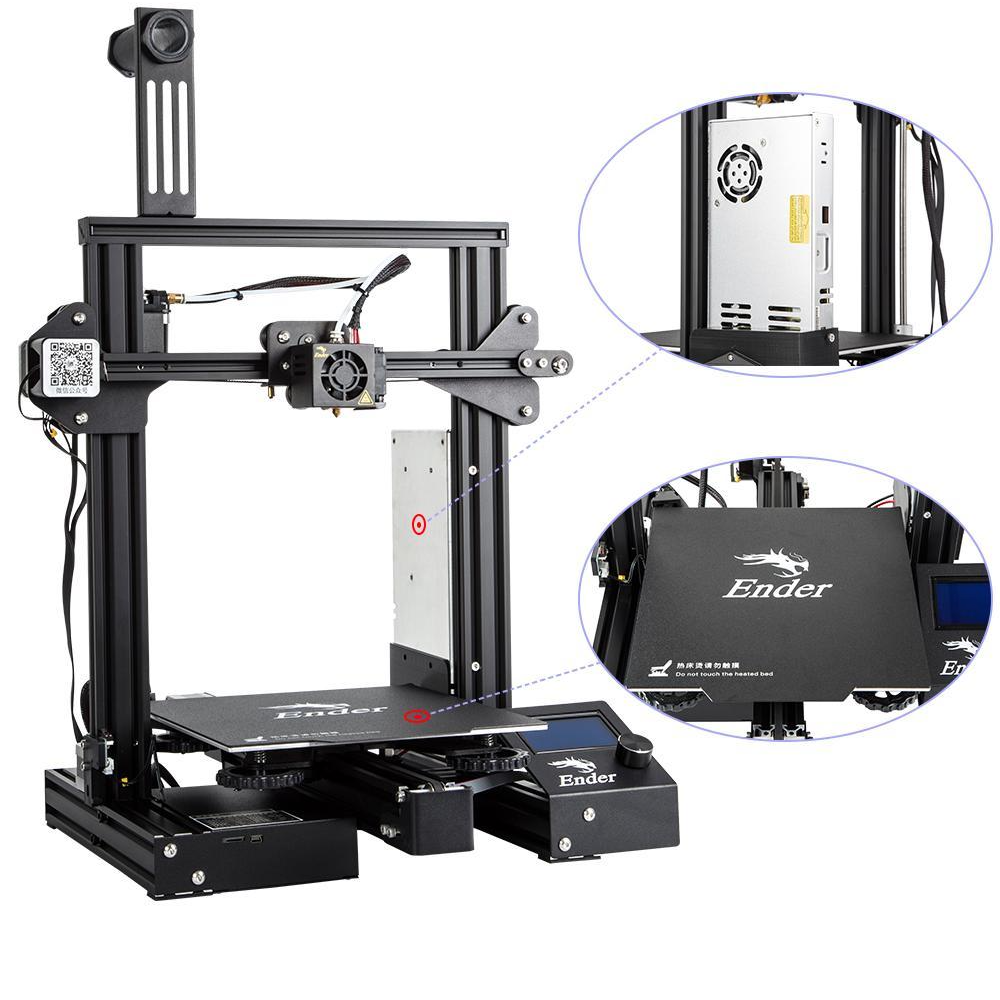
Quick Summary :
In the ever-expanding realm of 3D printing, the Creality Ender 3 has emerged as a shining star, particularly for beginners eager to delve into this innovative world. Packed with features that balance user-friendliness and performance, the Ender 3 offers a seamless introduction to 3D printing, making it an ideal choice for those taking their first steps in this exciting hobby.
1. Affordability and Value for Money:
One of the standout advantages of the Creality Ender 3 is its affordability without compromising on quality. For beginners exploring 3D printing, the Ender 3 provides an excellent entry point, offering impressive capabilities at a fraction of the cost compared to many other 3D printers on the market. This affordability ensures that beginners can embark on their 3D printing journey without breaking the bank.
2. Ease of Assembly and Use:
The Ender 3 is renowned for its straightforward assembly process, making it an ideal choice for those new to 3D printing. With a user-friendly design and clear instructions, even individuals with minimal technical experience can set up the printer with ease. This simplicity extends to its day-to-day operation, providing beginners with a hassle-free printing experience. The printer’s open-frame design also allows users to observe the printing process, fostering a deeper understanding of how 3D printing works.
3. Impressive Print Quality:
Despite its budget-friendly nature, the Creality Ender 3 does not compromise on print quality. The printer boasts a heated print bed, ensuring better adhesion and reduced warping, leading to more precise and reliable prints. The ability to print with various filaments, including PLA, ABS, and TPU, gives beginners the flexibility to experiment with different materials and discover the full spectrum of 3D printing possibilities.
4. Upgradability and Community Support:
The Ender 3 has gained immense popularity within the 3D printing community, resulting in a plethora of available upgrades and modifications. This not only allows users to enhance the printer’s capabilities over time but also fosters a sense of community collaboration. Beginners can tap into this wealth of knowledge, accessing forums, tutorials, and online communities to troubleshoot issues, seek advice, and explore exciting modifications that can take their 3D printing experience to the next level.
5. Compact Design and Space Efficiency:
The Ender 3’s compact and sturdy design makes it an excellent choice for users with limited space. Its small footprint allows it to fit comfortably on desks or workstations without monopolizing valuable real estate. This feature is particularly appealing to beginners who may not have dedicated workshops or expansive work areas, making the Ender 3 an accessible and convenient choice for 3D printing enthusiasts.
Conclusion:
In the realm of 3D printing, the Creality Ender 3 stands out as a beacon for beginners, offering an unbeatable combination of affordability, user-friendliness, and impressive print quality. Aspiring makers and creators can confidently embrace the world of 3D printing with the Ender 3, as it opens the door to endless possibilities while providing a solid foundation for learning and exploration in this captivating field.
5. Creality Ender 3 V2 Neo
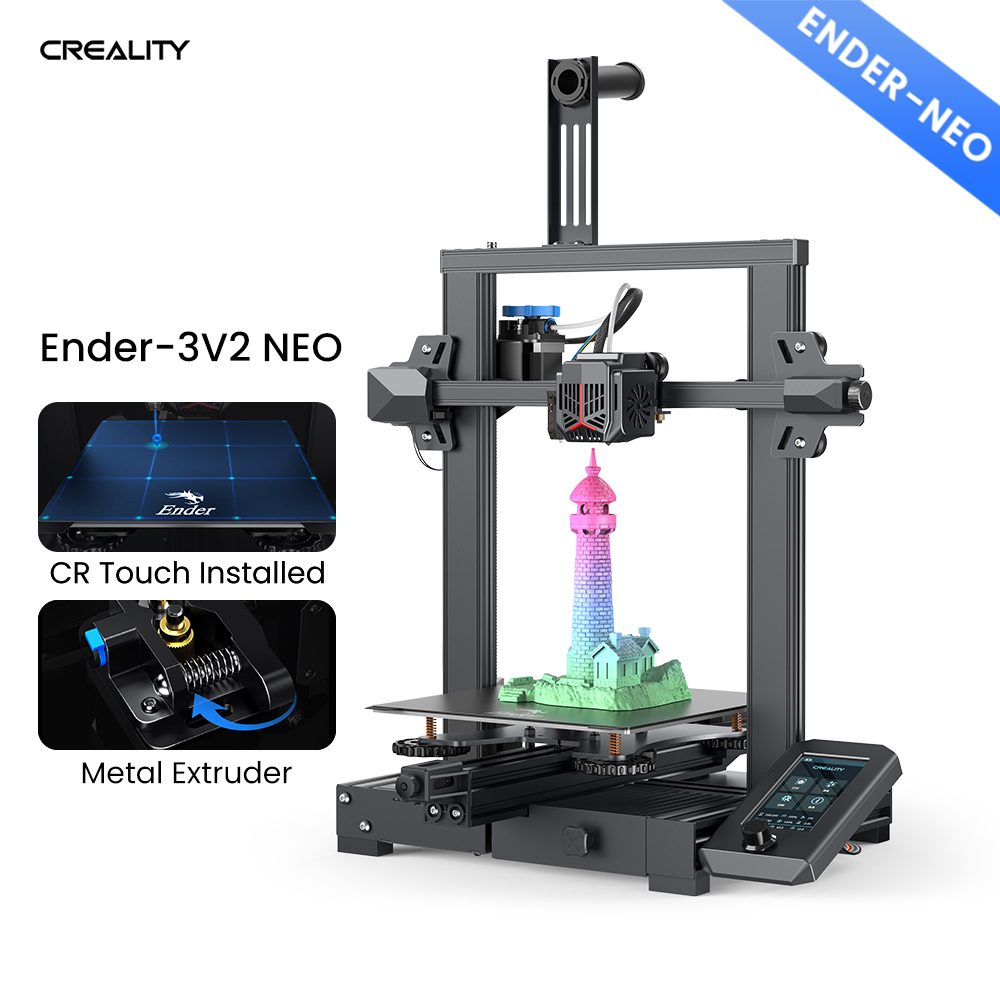
Quick Summary :
Stepping into the world of 3D printing can be both exciting and daunting for beginners. The Creality Ender 3 V2 Neo emerges as a beacon of accessibility, offering a myriad of benefits tailored for those just starting their 3D printing journey.
1. User-Friendly Design:
The Ender 3 V2 Neo is crafted with beginners in mind, featuring a user-friendly design that simplifies the printing process. Its straightforward assembly, aided by detailed instructions and an online community for support, ensures even those with minimal technical expertise can set up the printer with ease.
2. Affordability without Compromise:
Cost can be a significant concern for newcomers, and the Ender 3 V2 Neo addresses this by providing an affordable entry point into 3D printing without compromising on quality. Its budget-friendly price tag doesn’t hinder its capabilities, making it an ideal choice for those looking to explore the world of 3D printing without breaking the bank.
3. Sturdy Construction and Upgradability:
The printer’s robust frame and construction contribute to its reliability and stability during printing. Additionally, the Ender 3 V2 Neo is highly customizable, allowing beginners to gradually enhance and upgrade components as their skills and understanding of 3D printing evolve.
4. Silent Printing Experience:
One common concern with 3D printers is the noise they generate during operation. The Ender 3 V2 Neo tackles this issue with a silent stepper motor drive, providing a quieter printing experience. This is particularly advantageous for users who want to set up their printer in shared living spaces.
5. Decisive Print Quality:
Despite being a budget-friendly option, the Ender 3 V2 Neo delivers impressive print quality. With a printing volume of 220 x 220 x 250 mm, users can produce detailed and accurate prints, making it suitable for a wide range of applications, from prototyping to creating functional objects.
6. Intuitive User Interface:
The printer comes equipped with a user-friendly interface, featuring a responsive touchscreen. This intuitive control panel allows beginners to navigate through settings effortlessly, adjusting parameters and initiating prints without any hassle.
7. Open-Source Community Support:
The Ender 3 V2 Neo benefits from the thriving open-source 3D printing community. This means access to a plethora of resources, including firmware updates, mods, and a supportive community ready to assist beginners in troubleshooting and optimizing their printing experience.
Conclusion:
In summary, the Creality Ender 3 V2 Neo stands as an exemplary choice for beginners venturing into the world of 3D printing. Its user-friendly design, affordability, sturdy construction, and exceptional print quality make it a standout option, proving that top-notch 3D printing experiences are within reach for everyone, regardless of their level of expertise.
6. Anycubic Kobra Max
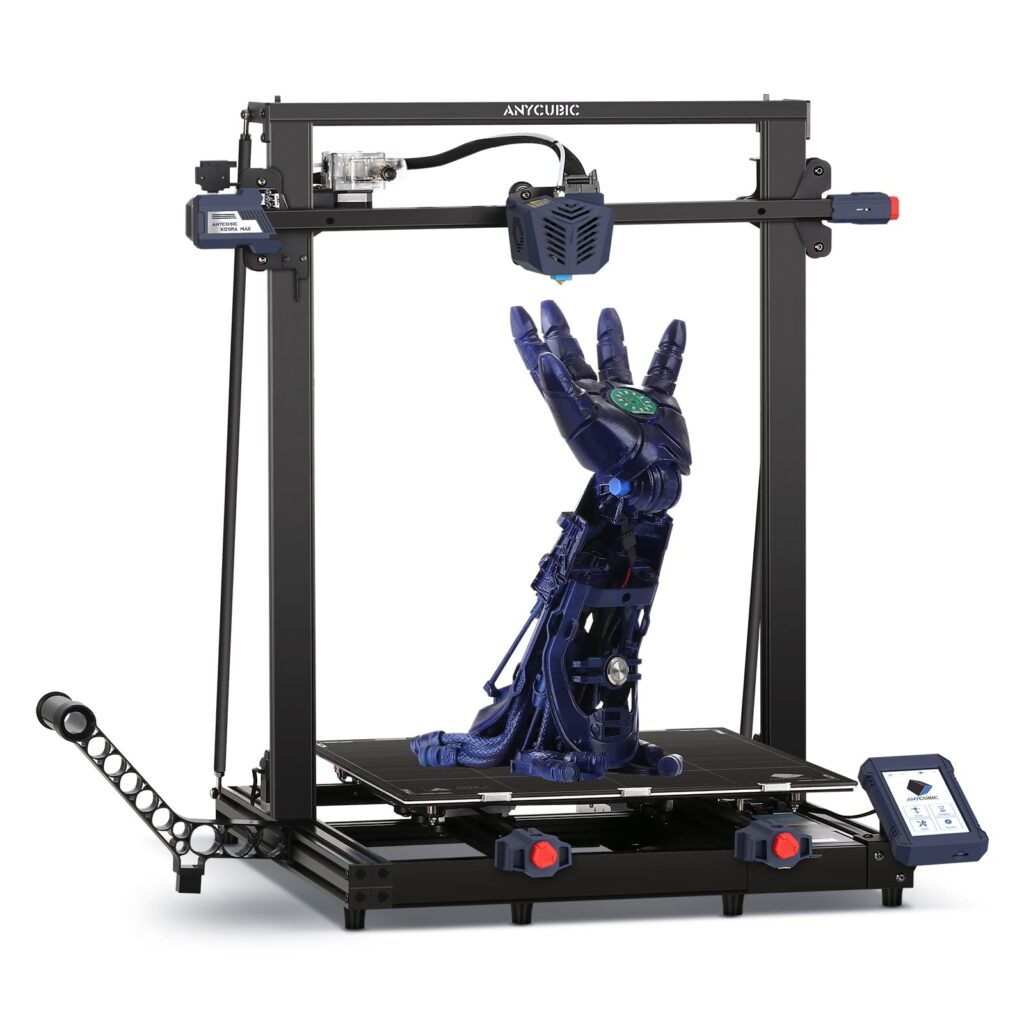
Quick Summary :
Embarking on the exciting journey of 3D printing can be both thrilling and overwhelming for beginners. The Anycubic Kobra Max emerges as a beacon of accessibility and innovation, offering a myriad of benefits tailored to newcomers in the world of 3D printing.
1. User-Friendly Design:
The Anycubic Kobra Max boasts an intuitive and user-friendly design, making it an ideal choice for those stepping into the realm of 3D printing for the first time. The simplified assembly process ensures that even beginners can set up the printer with ease, without compromising on functionality or performance.
2. Auto-Leveling Technology:
One of the standout features for beginners is the Anycubic Kobra Max’s auto-leveling technology. This innovation eliminates the need for manual bed leveling, a common source of frustration for newcomers. The printer’s self-leveling capabilities ensure that prints adhere seamlessly to the build surface, promoting consistency and quality.
3. Versatility in Filament Compatibility:
For beginners keen on exploring a variety of materials, the Anycubic Kobra Max provides versatility in filament compatibility. From PLA to ABS and beyond, this printer accommodates a wide range of filaments, allowing users to experiment with different materials and expand their creative horizons.
4. Large Printing Volume:
Despite its beginner-friendly design, the Anycubic Kobra Max doesn’t compromise on print size. The printer’s generous build volume provides ample space for creating larger and more intricate 3D prints, allowing beginners to take on diverse projects without limitations.
5. Silent Printing Experience:
The printer’s advanced stepper motor drivers contribute to a notably quiet printing experience. This is particularly beneficial for beginners who may be setting up their 3D printer in shared spaces, ensuring a peaceful environment while the Anycubic Kobra Max brings their creations to life.
6. Touchscreen Interface:
Navigating the world of 3D printing is made simpler with the Anycubic Kobra Max’s user-friendly touchscreen interface. Beginners can easily control and monitor their prints, adjusting settings with just a few taps on the intuitive display. This eliminates the need for complex manual adjustments and streamlines the overall printing process.
Conclusion:
In conclusion, the Anycubic Kobra Max stands out as a perfect companion for beginners venturing into the exciting realm of 3D printing. Its user-friendly design, auto-leveling technology, versatility in filament compatibility, large printing volume, silent operation, and touchscreen interface collectively make it an attractive option for those seeking a seamless and rewarding introduction to the world of additive manufacturing.
7. Creality K1 3D Printer
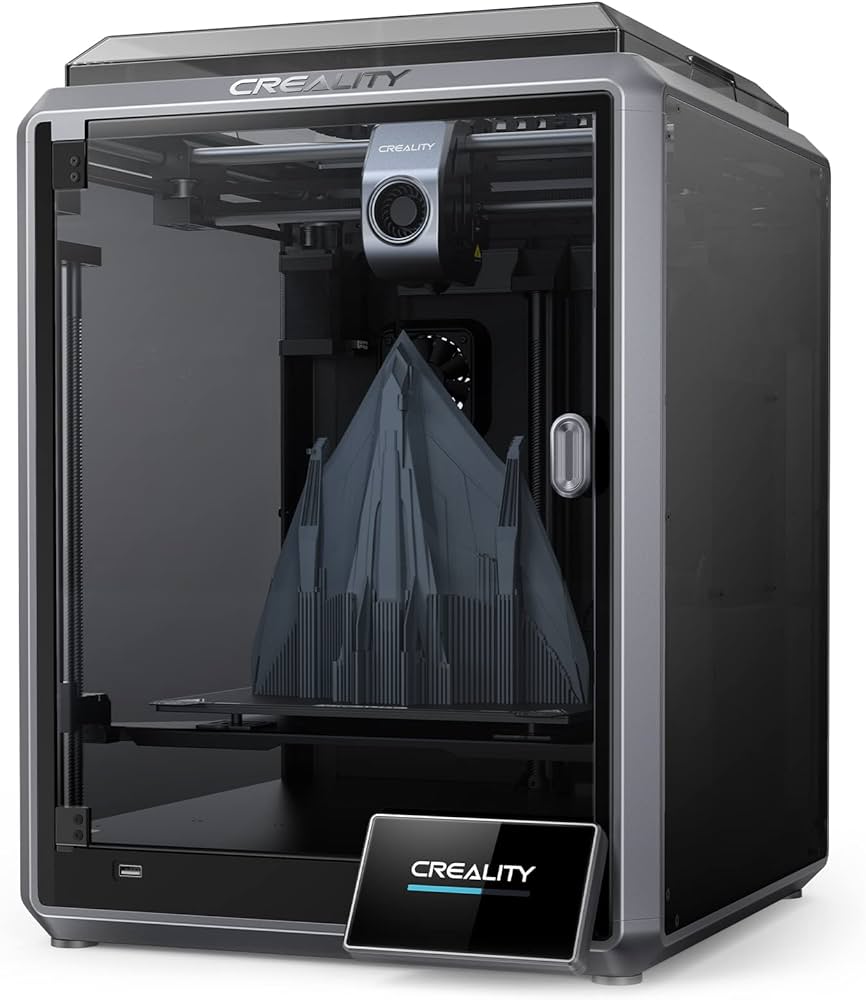
Quick Summary:
In the dynamic world of 3D printing, the Creality K1 stands out as an exceptional choice for beginners eager to delve into the realm of creative possibilities. This versatile 3D printer offers a host of benefits that make it an ideal companion for those taking their first steps in the exciting journey of additive manufacturing.
1. User-Friendly Design:
The Creality K1 boasts a user-friendly design that caters to beginners. Its straightforward assembly process and intuitive interface ensure a hassle-free setup, allowing users to focus on their creative endeavors rather than grappling with complex configurations. The printer’s sturdy frame and reliable components contribute to a seamless printing experience for those just starting.
2. Plug-and-Play Operation:
One of the standout features of the Creality K1 is its plug-and-play functionality. Beginners can dive into 3D printing without the need for extensive technical knowledge. The printer comes pre-calibrated, reducing the learning curve and enabling users to initiate their projects almost instantly. This convenience is particularly appealing to newcomers who may be daunted by the prospect of intricate setup procedures.
3. Versatility in Material Compatibility:
The Creality K1 supports a wide range of printing materials, including PLA, ABS, PETG, and more. This versatility empowers beginners to experiment with different filaments, discovering the unique properties and applications of each. The printer’s heated bed further expands material options, facilitating the creation of diverse projects with varying requirements.
4. Impressive Print Quality:
Despite its beginner-friendly nature, the Creality K1 does not compromise on print quality. The printer’s high precision and reliable extrusion system contribute to detailed and accurate prints. This ensures that beginners can bring their visions to life with impressive results, laying a solid foundation for their 3D printing journey.
5. Affordability without Sacrificing Features:
The Creality K1 strikes a balance between affordability and features, making it an attractive option for beginners on a budget. Its competitive price point does not compromise on essential functionalities, providing users with a reliable and feature-rich 3D printing experience without breaking the bank.
6. Responsive Customer Support:
Creality is known for its excellent customer support, and the Creality K1 is no exception. Beginners can take advantage of responsive assistance and a robust community of users, ensuring that any challenges encountered along the way can be swiftly addressed. This support network adds an extra layer of confidence for those venturing into 3D printing for the first time.
Conclusion:
In conclusion, the Creality K1 3D printer stands as a beacon for beginners, offering a user-friendly experience, versatile material compatibility, impressive print quality, affordability, and responsive customer support. Aspiring makers and creators can confidently embrace the world of 3D printing with the Creality K1, unlocking a realm of creative possibilities right at their fingertips.
8. Original Prusay i3 MK3S+

Quick Summary:
Embarking on the exciting journey of 3D printing can be both thrilling and overwhelming for beginners. To ease this initiation, the Original Prusa i3 MK3S+ stands out as an exemplary choice. In this comprehensive guide, we will delve into the myriad benefits that make this 3D printer a perfect companion for those just starting in the world of additive manufacturing.
1. User-Friendly Design:
The Prusa i3 MK3S+ boasts a user-friendly design that caters to beginners with its intuitive assembly process. The kit includes detailed instructions, ensuring a smooth setup even for those with minimal technical expertise. The well-thought-out design simplifies the learning curve, providing an accessible entry point for newcomers to 3D printing.
2. Reliability and Stability:
One of the key concerns for beginners is the reliability of their 3D printer. The Prusa i3 MK3S+ addresses this worry with its robust construction and high-quality components. The sturdy frame enhances stability during printing, resulting in consistent and reliable output. This reliability is crucial for beginners who seek a hassle-free printing experience without constant troubleshooting.
3. Automatic Bed Leveling and Calibration:
Bed leveling and calibration can be daunting tasks for beginners. The MK3S+ alleviates this challenge with its innovative automatic bed leveling system. This feature ensures that the print bed is perfectly leveled before each print, eliminating one of the common sources of frustration for newcomers. The printer’s self-calibrating capability contributes to a smoother and more enjoyable printing experience.
4. Versatility in Filament Compatibility:
The Prusa i3 MK3S+ offers versatility in filament compatibility, allowing beginners to experiment with a variety of materials. From PLA to PETG and beyond, this printer supports a wide range of filaments, enabling users to explore different textures, colors, and properties. This versatility opens the door to creative possibilities and expands the horizons of 3D printing for beginners.
5. Upgradability and Community Support:
As beginners advance in their 3D printing journey, the MK3S+ accommodates growth through upgradability. The Prusa community is renowned for its support and wealth of knowledge, providing resources for users to enhance and customize their printers. This collaborative environment ensures that beginners can evolve with their printer and stay abreast of the latest developments in the 3D printing realm.
Conclusion:
The Original Prusa i3 MK3S+ emerges as a beacon for beginners entering the world of 3D printing, offering a seamless and enjoyable experience. From its user-friendly design to reliable performance and versatile capabilities, this printer sets the stage for creative exploration. Investing in the Prusa i3 MK3S+ not only provides a reliable starting point for beginners but also lays the foundation for a fulfilling and enduring journey into the captivating realm of 3D printing.
9. Elegoo Mars 2 Pro
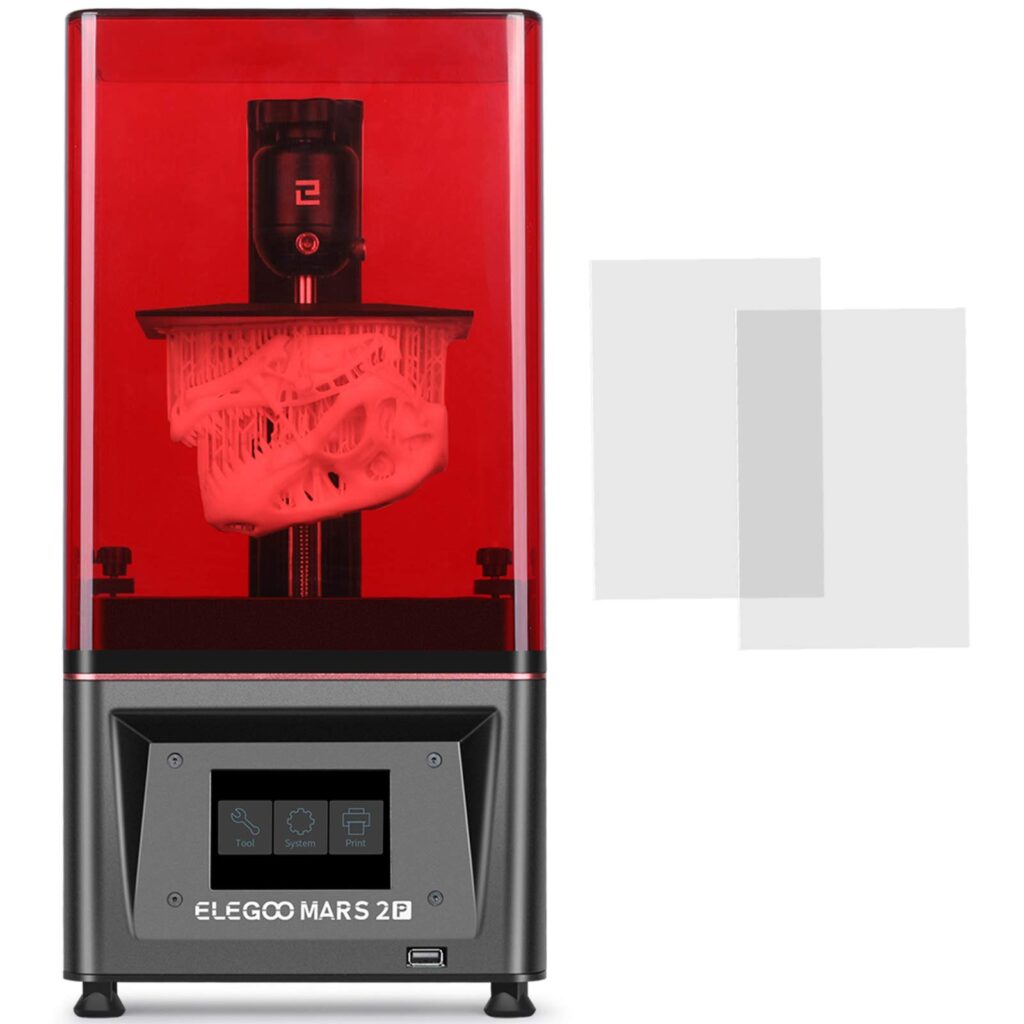
Quick Summary:
The world of 3D printing has witnessed a surge in user-friendly devices, and the Elegoo Mars 2 Pro stands out as a game-changer for beginners diving into this exciting realm. Packed with features tailored for ease of use and impressive results, this cutting-edge resin 3D printer offers a seamless experience for those taking their first steps in the world of additive manufacturing.
1. High Precision Printing:
One of the standout benefits of the Elegoo Mars 2 Pro is its exceptional precision. Equipped with a monochrome LCD and a 2K resolution, this printer ensures that every layer is meticulously crafted. Beginners can achieve intricate details in their prints without compromising on quality, setting the stage for stunning creations right from the start.
2. User-Friendly Interface:
Navigating a 3D printer can be daunting for newcomers, but Elegoo has addressed this concern with a user-friendly interface. The 3.5-inch touch screen allows for intuitive control, making it easy for beginners to access and adjust settings. The straightforward menu system streamlines the printing process, minimizing the learning curve and empowering users to focus on their creative endeavors.
3. Fast Printing Speed:
Patience is a virtue, but in the fast-paced world of 3D printing, speed matters. The Mars 2 Pro boasts impressive printing speeds, allowing beginners to witness the transformation of their digital designs into tangible objects in a fraction of the time compared to other printers. This feature not only enhances productivity but also keeps the excitement alive throughout the printing journey.
4. Sturdy Build and Durability:
Elegoo has crafted the Mars 2 Pro with durability in mind, ensuring a sturdy build that withstands the rigors of 3D printing. The robust construction contributes to the printer’s longevity, making it a reliable companion for beginners who want a device that can evolve with their growing skills and projects.
5. Resin Compatibility and Versatility:
The Elegoo Mars 2 Pro is compatible with a variety of resins, providing users with the flexibility to experiment with different materials. This versatility allows beginners to explore a wide range of applications, from creating detailed miniatures to prototyping functional parts. The ability to adapt to various resin types enhances the printer’s utility for those eager to explore the diverse possibilities of 3D printing.
Conclusion:
In the realm of 3D printing, the Elegoo Mars 2 Pro stands tall as a beacon for beginners. Its combination of precision, user-friendly interface, speed, durability, and versatility makes it an ideal choice for those embarking on their 3D printing journey. With the Elegoo Mars 2 Pro by their side, beginners can unlock the door to a world of limitless creativity and innovation.
10. HALOT-MAGE 8K Resin 3D Printer
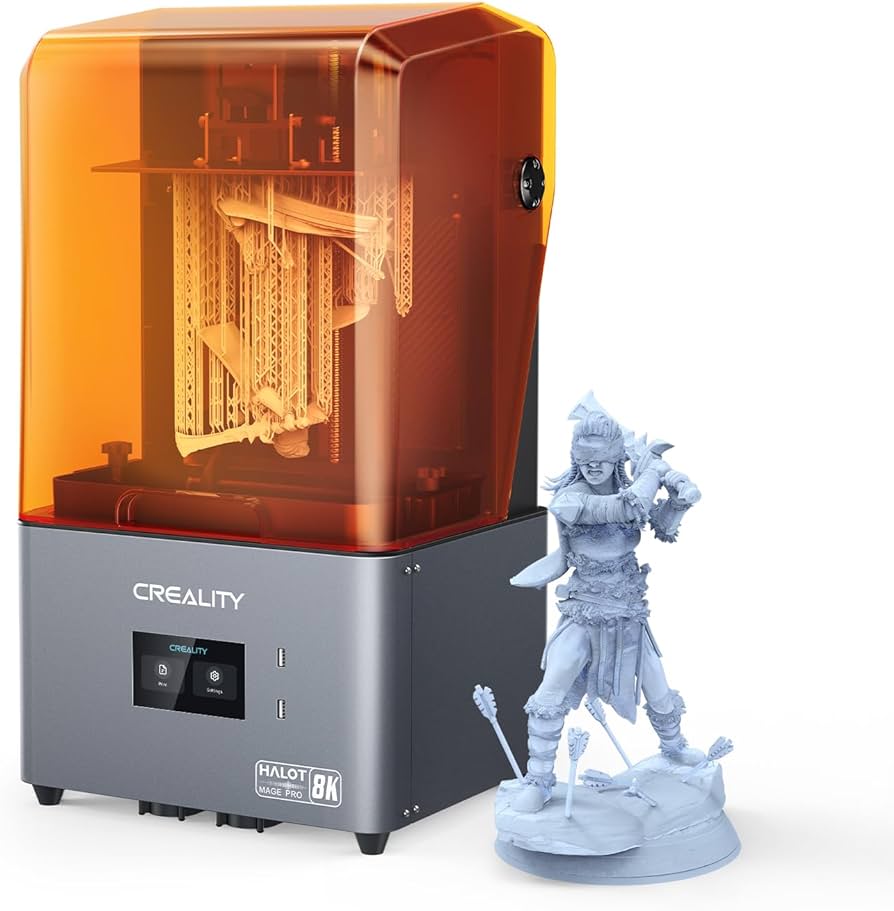
Quick Summary:
3D printing has evolved into a transformative technology, and for beginners, the HALOT-MAGE 8K Resin 3D Printer stands out as an exceptional choice. Packed with advanced features and user-friendly functionalities, this printer caters to the needs of novices eager to explore the world of three-dimensional printing.
1. High-Resolution Printing:
HALOT-MAGE 8K takes the visual experience to the next level with its impressive 8K resolution capability. For beginners keen on producing intricate and detailed prints, this feature ensures that every layer is crafted with precision, bringing designs to life in stunning clarity.
2. User-Friendly Interface:
The learning curve for 3D printing can be daunting, especially for beginners. HALOT-MAGE 8K simplifies this journey with its user-friendly interface. The intuitive controls and straightforward navigation make it easy for newcomers to set up, calibrate, and initiate prints without feeling overwhelmed.
3. Versatile Printing Materials:
Catering to the creative aspirations of beginners, HALOT-MAGE 8K supports a variety of printing materials. From standard resins to specialty options, users can experiment with different materials to achieve the desired properties in their prints, expanding the scope of creative possibilities.
4. Efficient Print Speed:
Time is often a crucial factor, and HALOT-MAGE 8K addresses this concern with its efficient print speed. Beginners can witness their creations materialize swiftly without compromising on the quality of the final output, making the printing process both efficient and satisfying.
5. Reliable Stability and Durability:
The HALOT-MAGE 8K is built to last, providing a stable printing platform for beginners to rely on. The robust construction ensures minimal vibrations and precise layering, contributing to the overall durability of the printer and the consistency of print quality.
6. Enclosed Printing Chamber:
Maintaining a controlled printing environment is essential for successful 3D printing. HALOT-MAGE 8K features an enclosed printing chamber that helps regulate temperature and protects prints from external factors, ensuring optimal conditions for consistent and reliable outcomes.
7. Upgradability for Future Exploration:
As beginners progress in their 3D printing journey, the HALOT-MAGE 8K remains a companion that can grow with them. The printer’s upgradability options allow users to incorporate new features and technologies, ensuring that it stays relevant as their skills and projects advance.
Conclusion:
In the realm of 3D printing for beginners, the HALOT-MAGE 8K Resin 3D Printer shines as a beacon of innovation and accessibility. With its combination of high-resolution printing, user-friendly interface, versatility, efficiency, stability, and upgradability, it offers a comprehensive solution for newcomers eager to embark on their creative journey in the world of 3D printing.
Key Takeaways
- There are many factors to consider when choosing a 3D printer for beginners, such as ease of use, build quality, print quality, and price.
- This list of the top 10 3D printers for beginners in 2024 provides a great starting point for those looking to get into 3D printing.
- With the right machine, beginners can create a wide range of objects, from custom phone cases to replacement parts for household items.
Understanding 3D Printing
3D Printing Basics for Beginners
It is a revolutionary technology that has been gaining popularity in recent years due to its versatility and ease of use. The process involves building a physical object layer by layer using a 3D printer. The printer reads a 3D model file and deposits material layer by layer until the object is complete.
Types of 3D Printing Technologies
There are several types of 3D printing technologies available, each with its own unique advantages and disadvantages. The most commonly used technologies are Fused Deposition Modeling (FDM), Stereolithography (SLA), and Selective Laser Sintering (SLS).
- Fused Deposition Modeling (FDM): This is the most popular 3D printing technology for beginners. It involves melting a plastic filament and extruding it layer by layer to build the object. It is affordable, easy to use, and produces high-quality prints.
- Stereolithography (SLA): This technology uses a liquid resin that is cured by a UV laser to build the object. It produces high-resolution prints with smooth surfaces, but it is more expensive than FDM and requires more maintenance.
- Selective Laser Sintering (SLS): This technology uses a laser to melt a powdered material and fuse it together to build the object. It is used for high-end industrial applications and produces high-quality prints, but it is expensive and requires specialized equipment.
Beginners should choose a 3D printing technology based on their budget, skill level, and intended use of the printed object. FDM is the most beginner-friendly and affordable option, while SLA and SLS are better suited for professionals and advanced users.
Choosing Your First 3D Printer
When it comes to buying your first 3D printer, there are several factors to consider to ensure that you get the best value for your money. This section will explore some of the most important factors to consider when buying a 3D printer for beginners.
Factors to Consider When Buying a 3D Printer
Printing Technology
3D Printers have Two main types of 3D printing technologies: Fused Deposition Modeling (FDM) and Stereolithography (SLA). FDM printers are more affordable and easier to use, making them ideal for beginners. SLA printers, on the other hand, produce higher quality prints but are more expensive and require more maintenance.
Build Volume
The build volume of a 3D printer refers to the maximum size of the object that it can print. Beginners should consider the size of the objects they plan to print and choose a printer with a build volume that suits their needs.
Ease of Use
For beginners, ease of use is a crucial factor to consider. Look for a printer with a user-friendly interface, easy-to-follow instructions, and good technical support.
Price Versus Quality for Beginner Printers
When it comes to buying a 3D printer for beginners, it’s essential to strike a balance between price and quality. While it may be tempting to go for the cheapest option, it’s important to remember that you get what you pay for. Cheaper printers may have lower quality parts, resulting in lower quality prints.
However, that doesn’t mean you need to break the bank to get a good quality printer. There are plenty of affordable options on the market that offer excellent value for money. Look for printers that offer a good balance between price and quality, and don’t be afraid to invest a little more for a higher quality printer that will last longer and produce better prints.
Overall, when choosing your first 3D printer, it’s important to consider your needs, budget, and skill level. By taking the time to research and compare different models, you can find a printer that meets your needs and helps you get started with 3D printing.
These are the top 10 3D printers for beginners in 2024. Each printer has its own unique features, so choose the one that best suits your needs and budget.
Setting Up Your 3D Printer
Step-by-Step Setup Guide
Setting up a 3D printer may seem intimidating at first, but following the manufacturer’s instructions can make the process much easier. Most 3D printers come with a user manual that includes a step-by-step guide on how to set up the printer. These guides typically include instructions on how to assemble the printer, how to connect it to your computer, and how to load the filament.
It is important to follow the instructions carefully and take your time during the setup process. Rushing through the setup can lead to mistakes that can cause problems later on. Additionally, it is important to make sure that the printer is set up on a flat and stable surface to prevent any wobbling during the printing process.
Calibrating Your 3D Printer
Calibrating your 3D printer is an important step in ensuring that your prints come out correctly. Calibration involves adjusting the printer’s settings to ensure that the print bed is level and that the nozzle is at the correct height from the bed.
Most 3D printers come with an automatic calibration feature that makes the process much easier. However, it is still important to double-check the calibration to ensure that it is accurate. This can be done by printing a calibration test print and checking the results.
In addition to calibrating the printer, it is important to make sure that the filament is loaded correctly and that the printer’s temperature settings are correct for the type of filament being used. These settings can be found in the printer’s user manual or on the manufacturer’s website.
By following these steps, beginners can set up their 3D printers with confidence and start printing their own creations in no time.
Getting Started with Your First Print
Congratulations on purchasing your first 3D printer! Now it’s time to start printing. But where do you begin? This section will guide you through the process of choosing your first project and understanding the filaments used in 3D printing.
Choosing Your First Project
As a beginner, it’s important to choose a project that is simple and easy to print. Some great options include keychains, phone cases, and small figurines. These projects are readily available online and can be found on websites such as Thingiverse and MyMiniFactory.
When choosing your first project, it’s important to consider the size and complexity of the object. A smaller object with simple shapes and minimal details will be easier to print than a larger object with intricate designs. It’s also important to choose a project that is within the build volume of your printer, which can be found in the specifications of your printer.
Understanding 3D Printing Filaments
3D printing filaments are the materials used to create the object being printed. The most common filaments used in 3D printing are PLA and ABS. PLA is a biodegradable and easy-to-use filament that is perfect for beginners. ABS is a more durable filament that requires a higher printing temperature and more advanced printing skills.
Other filaments include PETG, TPU, and Nylon, each with their own unique properties and uses. It’s important to research and understand the properties of each filament before choosing which one to use for your project.
In addition to the type of filament, it’s also important to consider the diameter of the filament. The most common diameters are 1.75mm and 2.85mm. Make sure to check the specifications of your printer to ensure that you are using the correct diameter filament.
By choosing a simple project and understanding the filaments used in 3D printing, beginners can successfully create their first print. With practice and experience, more complex projects can be tackled.
Troubleshooting Common Issues
3D printing can be a challenging task, especially for beginners. In this section, we will discuss some of the most prominent problems you may encounter and solutions to fix them.
Print Quality Problems and Solutions
Layer Shifting
Layer shifting occurs when the layers of the 3D print are not aligned correctly, resulting in a distorted print. This problem can be caused by several factors, including loose belts, incorrect stepper motor settings, or a malfunctioning motor.
To fix this issue, first, check the belts and tighten them if necessary. Then, check the stepper motor settings and ensure they are correct. If the problem persists, consider replacing the motor.
Warping
To fix this issue, ensure that the print bed is level. Also, use a heated bed and ensure that the temperature is set correctly. Finally, consider using a brim or raft to increase adhesion to the bed.
Hardware Malfunctions and Fixes
Extruder Jamming
Extruder jamming occurs when the filament gets stuck in the extruder, preventing it from extruding correctly. This problem can be caused by several factors, including a clogged nozzle, incorrect temperature settings, or a dirty extruder gear.
To fix this issue, first, check the nozzle and ensure it is not clogged. Then, check the temperature settings and ensure they are correct. If the problem persists, consider cleaning the extruder gear or replacing it.
Bed Adhesion Issues
Bed adhesion issues occur when the 3D print does not stick to the bed correctly, resulting in a failed print. This problem can be caused by several factors, including incorrect bed leveling, incorrect bed temperature, or a dirty print bed.
To fix this issue, first, ensure that the bed is level. Then, check the bed temperature and ensure it is set correctly. If the problem persists, consider cleaning the print bed or using a different bed adhesion method, such as glue or tape.
By following these troubleshooting tips, beginners can overcome some of the most common issues encountered during 3D printing. Remember to always double-check the settings and hardware before printing to ensure a successful print.
Maintenance and Upkeep
Regular Maintenance Tasks
To ensure that your 3D printer is always in good working condition, it is important to perform regular maintenance tasks. The following are some of the tasks that should be performed on a regular basis:
- Cleaning: Regular cleaning of the printer is important to ensure that it is free from dust, debris, and other contaminants that can negatively impact the quality of the prints. Use a soft, dry cloth to wipe down the printer’s exterior and clean the print bed with a damp cloth.
- Lubrication: Lubricating the moving parts of the printer is important to ensure that they operate smoothly and quietly. Use a high-quality lubricant to lubricate the rails, bearings, and other moving parts of the printer.
- Calibration: Regular calibration of the printer is important to ensure that it is printing accurately and producing high-quality prints. Follow the manufacturer’s instructions to calibrate the printer.
- Filament Management: Proper management of the filament is important to ensure that it is stored correctly and does not become tangled or damaged. Store the filament in a dry, cool place and use a filament guide to prevent tangling.
Upgrading Your 3D Printer
Upgrading your 3D printer can be a great way to improve its performance and capabilities. The following are some of the upgrades that you may want to consider:
- Hotend Upgrade: Upgrading the hotend can improve the quality of the prints and allow you to print with a wider range of materials.
- Extruder Upgrade: Upgrading the extruder can improve the reliability and speed of the printer.
- Bed Upgrade: Upgrading the print bed can improve the adhesion of the prints and allow you to print with a wider range of materials.
- Controller Board Upgrade: Upgrading the controller board can improve the accuracy and speed of the printer.
By performing regular maintenance tasks and upgrading your 3D printer as needed, you can ensure that it continues to produce high-quality prints and meets your needs for years to come.
Enhancing Your 3D Printing Skills
Learning Resources and Communities
As a beginner, it’s important to have access to learning resources and communities to enhance your 3D printing skills. There are many online resources available, including YouTube tutorials, blogs, and forums. One popular resource is Thingiverse, a website where users can share 3D models and connect with other 3D printing enthusiasts. Another great resource is MyMiniFactory, which offers a wide range of 3D models and tutorials for beginners.
Joining a 3D printing community can also be beneficial for beginners. These communities offer a space to connect with other 3D printing enthusiasts, ask for advice, and share your own work. Some popular communities include r/3Dprinting on Reddit and the 3D Printing Community on Facebook.
Advanced Techniques for Beginners
Once you have mastered the basics of 3D printing, there are many advanced techniques that you can explore. One technique is multicolor printing, which allows you to print objects with multiple colors. Some 3D printers have the ability to print with multiple filaments, while others require manual filament changes.
Another advanced technique is using support structures, which are temporary structures that support overhanging parts of your print. Support structures can be generated automatically by your slicing software, or you can create them manually.
Finally, you can experiment with different types of filaments, such as flexible filaments or wood-infused filaments, to create unique prints. It’s important to note that not all 3D printers can handle all types of filaments, so be sure to check your printer’s specifications before experimenting.
By utilizing learning resources and communities and exploring advanced techniques, beginners can enhance their 3D printing skills and create even more impressive prints.
Safety and Best Practices
3D Printing Safety Tips
When using a 3D printer, safety should always be a top priority. Here are a few tips to keep in mind:
- Always wear protective gear, such as gloves and safety glasses, when handling hot or sharp objects.
- Keep the printer in a well-ventilated area to avoid inhaling fumes from the printing materials.
- Do not touch the printer’s hot end or build plate while the printer is in operation.
- Keep the printer out of reach of children and pets.
- Always follow the manufacturer’s instructions and guidelines for safe operation.
Environmental Considerations
3D printing can have an impact on the environment, so it’s important to consider these factors when using a printer:
- Choose printing materials that are environmentally friendly and biodegradable when possible.
- Recycle or properly dispose of any waste materials generated by the printing process.
- Consider the energy consumption of the printer and try to minimize its use when not necessary.
- Consider using a 3D printing service instead of purchasing a printer if you only need occasional prints to reduce your environmental impact.
By following these safety and environmental considerations, beginners can ensure a safe and responsible 3D printing experience.
Future of 3D Printing for Hobbyists
Emerging Technologies
The future of 3D printing for hobbyists looks bright, with emerging technologies promising to bring exciting new possibilities to the industry. One such technology is metal 3D printing. While metal 3D printers have been around for some time, they have been prohibitively expensive for most hobbyists. However, recent advancements have made metal 3D printing more accessible, with prices dropping and new, more affordable machines hitting the market.
Another technology that is set to revolutionize 3D printing is carbon fiber 3D printing. Carbon fiber is an incredibly strong and lightweight material that is used in a variety of industries, including aerospace and automotive. While carbon fiber 3D printers are still relatively new, they are becoming more common and more affordable. As the technology improves, we can expect to see more and more hobbyists using carbon fiber 3D printers to create high-strength, lightweight parts.
The Expanding Market for Beginner Printers
As 3D printing becomes more popular, the market for beginner printers is expanding rapidly. Today, there are a plethora of affordable 3D printers on the market that are perfect for hobbyists looking to get started with 3D printing. These printers are easy to use and come with a range of features that make them ideal for beginners.
One of the most exciting developments in the beginner 3D printing market is the rise of modular printers. These printers allow users to easily swap out components, making it easy to upgrade and customize their machines. This means that hobbyists can start with a basic printer and gradually add new features and capabilities as they become more experienced.
Overall, the future of 3D printing for hobbyists looks bright, with new technologies and expanding markets promising to bring exciting new possibilities to the industry. As more and more people get involved in 3D printing, we can expect to see even more innovation and growth in the years to come.
Frequently Asked Questions
What are the best budget-friendly 3D printers for beginners in 2024?
There are several budget-friendly 3D printers available for beginners in 2024. The Creality Ender 3 V2 Neo and the Anycubic Kobra Max are both great options that cost less than $400 and offer a good balance of quality and affordability. The Bambu Lab P1P is another budget-friendly option that is great for fast printing.
Which 3D printers offer the largest build volume for beginners?
The Snapmaker A350T 3 in 1 3D Printer Laser Engraver CNC Machine has a large build volume of 320 x 350 x 400 mm, making it a great option for beginners who want to print large objects. The Anycubic Photon Mono X2 Resin 3D Printer also has a large build volume of 192 x 120 x 250 mm and is a great option for those interested in resin printing.
What are the top-rated beginner 3D printers available on Amazon in 2024?
The top-rated beginner 3D printers on Amazon in 2024 include the Creality Ender 3 V2 Neo, the Anycubic Kobra Max, and the Bambu Lab P1P. These printers are all affordable, easy to use, and offer good print quality.
How do entry-level 3D printers for small businesses compare in 2024?
Entry-level 3D printers for small businesses in 2024 are designed to be affordable and easy to use, while still offering good print quality. The Creality Ender 3 V2 Neo, the Anycubic Kobra Max, and the Bambu Lab P1P are all great options for small businesses looking to get started with 3D printing.
What features should I look for in my first 3D printer as a beginner?
When looking for your first 3D printer as a beginner, there are several features to consider. Look for a printer that is easy to use and has good print quality. It should also have a decent build volume and be compatible with a variety of filaments. Additionally, consider the price and any additional features, such as a heated bed or automatic bed leveling.
Are there any 3D printers under $500 that are suitable for beginners in 2024?
Yes, there are several 3D printers under $500 that are suitable for beginners in 2024. The Creality Ender 3 V2 Neo, the Anycubic Kobra Max, and the Bambu Lab P1P are all great options that cost less than $400. The Elegoo Mars 2 Pro is another affordable option that is great for beginners interested in resin printing.

